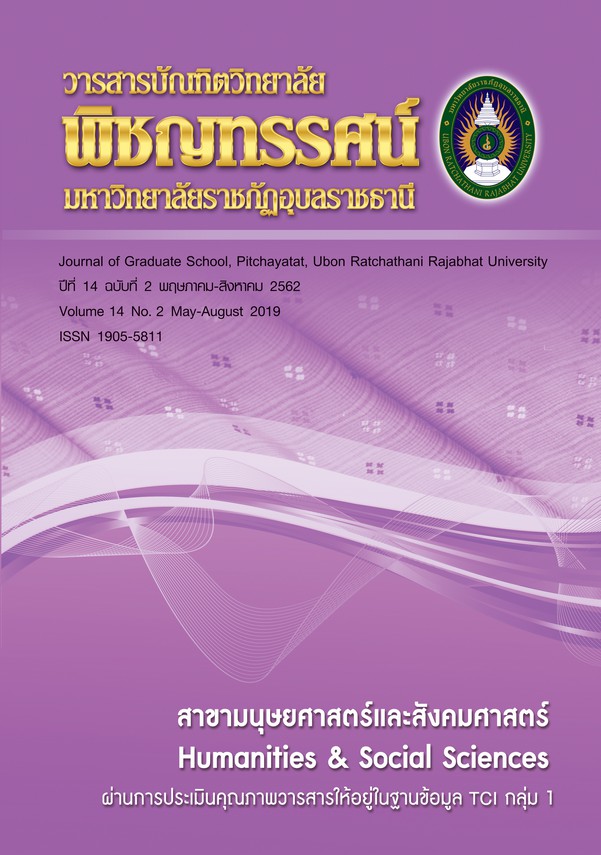The Relationship Between Cognitive Styles and Critical Thinking of Undergraduate Students at Surindra Rajabhat University
คำสำคัญ:
Cognitive Styles, Critical Thinking, Relationshipบทคัดย่อ
The objective of this research was to study the relationship between the cognitive styles and critical thinking of undergraduate students at Surindra Rajabhat University. The sample group was the first-year undergraduate students at Surindra Rajabhat University in the first semester of academic year 2018. There were 317 students which were collected by cluster random sampling. The instruments used in this research were a cognitive style test and a critical thinking ability test. The cognitive style test separated three styles of student thinking processes. These include an analytical style, a categorical style, and a relational style. The reliability of the cognitive style test yielded Cronbach's alpha coefficient of 0.709. Moreover, the critical thinking ability test could measure the levels of five critical thinking abilities namely inference making, recognition of assumptions, deduction, induction, and evaluation of arguments. The reliability of the critical thinking ability test was analyzed by the Lovett method at an 80 percent cut point which presented a score of 0.910. The data were analyzed by means, standard deviation, Pearson's correlation coefficient, and multiple regression analysis. The results of the research were as follows: The mean score of the critical thinking ability of students was 14.11 (S.D. = 2.473). The correlation coefficients of the variables found that the analytical style had a significant with the categorical style and the relational style but negative relationship at the .01 level. The categorical style had a significant with relational style but negative relationship at the .01 level. However, the correlation coefficients between cognitive styles and critical thinking showed that the analytical style and the categorical style had a significant with the critical thinking with a positive relationship at the .01 level while relational style had a significant with the critical thinking but had a negative relationship at the .01. Furthermore, the multiple regression influence from cognitive styles to critical thinking found that the three variables of cognitive styles that are important predictors of critical thinking gave a figure of 40.59%.
เอกสารอ้างอิง
Dehghayedi, M. and Bagheri, M.S. EFL Teachers’ Learning and Teaching Beliefs: Does Critical Thinking Make a Difference? International Journal of Instruction, 11, 4 (2018): 223–240.
Germaine, R., Richards, J., Koeller, M. Schubert-Irastorza, C. Purposeful Use of 21st Century Skills in Higher Education. Journal of Research in Innovative Teaching, 9(1), 19 – 29. 2016.
Hou, Y. Comparing Teacher- and Student-Focused Instruction on the Development of Critical Thinking Skills and Reading Comprehension. International Journal of Literacies, 25,1 (2018): 11–26.
Khumsawat, D. Factors of cognitive styles and critical thinking ability affecting learning achievement of Prathoom Suksa 6 Students. Master’s Thesis, Department of Research and Statistics in Education, Chiang Mai University, 2006.
Konlum, S. Effects of cognitive styles and feedback control in drill and practice in a computer-assisted instruction lesson on mathematics learning achievement of prathom suksa six students. Master’s Thesis, Department of Audio - Visual Communication, Chulalongkorn University, 2002.
National Education Association. Preparing 21st Century Students for a Global Society. (online) 2018 (cited in 25 August 2018). Available from: http://www.nea.org/assets/docs/A-Guide-to-Four-Cs.pdf.
Nold, H. Using Critical Thinking Teaching Methods to Increase Student Success: An Action Research Project. International Journal of Teaching and Learning in Higher Education, 29, 1 (2017):17 - 32.
Pattiyathani, S., Chatsuwan, J. and Kumdee, W. Critical Thinking Test. Journal of Educational Measurement Mahasarakham University. 13 (September 2005): 1 - 15. 2005.
Phengsawat, W. Experimental Research in Education. SNRU Journal of Science and Technology. 6(11) (January - June 2014), 181-190. 2014.
Pongdecha, D. The relationship between cognitive styles and critical thinking ability of Prathomsuksa vi students. Master’s Thesis, Department of Educational Measurement. Thaksin University, 1999.
Prangsorn, S. Cognitive Styles of teaching and learning. Journal of Vocational and Technical Education. 2,4 (July - December 2012): 4-13.
Promwang, N. Survey Research. (Online) 2010 (Cite 2018 Aug 18). Available from: https://rci2010.files. wordpress.com/ 2010/06/explore_research.pdf.
Sirisupluxana, P. Teaching Nursing Students to Develop Critical Thinking Skills. Journal of Boromarajonani College of Nursing, 19(2) (July - December 2013): 5 - 19. 2013.
Soreekul, N. Effects of coaching in case-based learning on web upon problem solving of mathayom suksa one students with different cognitive styles. Doctoral dissertation, Department of Curriculum Instructional and Educational Technology, Chulalongkorn University, 2004.
Tan, C. Teaching critical thinking: Cultural challenges and strategies in Singapore. British Educational Research Journal, 43,5 (2017): 988–1002.
The office of Academic Promotion and Registration. The report of student summary in academic year 2018. Surindra Rajabhat University. 2018.
Urairak, P. The Effects of Using the Research Processing Model Regarding Critical Thinking, Cognitive Inquiry, and Attitudes Toward Student Development Activities. Doctoral dissertation, Department of Educational Research, Ramkhamhaeng University, 2010.
Wannaratn, W. Test Score and Grading. Journal of Humanities and Social Science, Rajapauk University. 2, 3(October 2016 - January 2017): 1 - 11.
Watson, G. and Glaser E.M. Critical Thinking Appraisal – UK Edition. (online) 2009 (cited in 26 December 2017). Available from: https://us.talentlens.com/wp-content/uploads/pdf/WatsonGlaser_Short_Form_Manual.pdf.
White, J. 21st Century skills: a perspective from England. E-Pedagogium. 2 (April 2015): 51 - 61.
Witkin, H.A., Oltman, P.K., and Karp, S. A. A manual for the Embedded Figures Test. Palo Alto, CA: Consulting Psychologists Press, 1971.
Rojaphot, K., Tayraukham, S. and Chomeya, R. Comparisons of Ability to Analysis Thinking and Critical Thinking of Mahasarakham University Undergraduate Students a Gender Year and Study Group Different. Journal of Educational Measurement Mahasarakham University, 18, 1 (July 2012): 13 - 29.
ดาวน์โหลด
เผยแพร่แล้ว
รูปแบบการอ้างอิง
ฉบับ
ประเภทบทความ
สัญญาอนุญาต
บทความทุกเรื่องได้รับการตรวจความถูกต้องทางวิชาการโดยผู้ทรงคุณวุฒิภายนอกอย่างน้อย 3 คน ความคิดเห็นในวารสารพิชญทรรศน์เป็นความคิดเห็นของผู้นิพนธ์มิใช่ความคิดเห็นของผู้จัดทำ จึงมิใช่ความรับผิดชอบของวารสารพิชญทรรศน์ และบทความในวารสารพิชญทรรศน์สงวนสิทธิ์ตามกฎหมายไทย การจะนำไปเผยแพร่ต้องได้รับอนุญาตเป็นลายลักษณ์อักษรจากกองบรรณาธิการ





